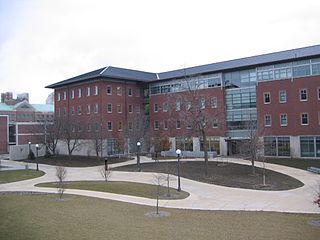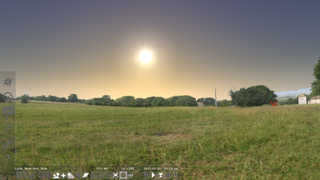
The National Center for Supercomputing Applications (NCSA) is a state-federal partnership to develop and deploy national-scale cyberinfrastructure that advances research, science and engineering based in the United States. NCSA operates as a unit of the University of Illinois Urbana-Champaign, and provides high-performance computing resources to researchers across the country. Support for NCSA comes from the National Science Foundation, the state of Illinois, the University of Illinois, business and industry partners, and other federal agencies.

A planetarium is a theatre built primarily for presenting educational and entertaining shows about astronomy and the night sky, or for training in celestial navigation.

Stellarium is a free and open-source planetarium, licensed under the terms of the GNU General Public License version 2 or any later version, available for Linux, Windows, and macOS. A port of Stellarium called Stellarium Mobile is available for Android, iOS, and Symbian as a paid version, being developed by Noctua Software. These have a limited functionality, lacking some features of the desktop version. All versions use OpenGL to render a realistic projection of the night sky in real time.

Celestia is a real-time 3D astronomy software program that was created in 2001 by Chris Laurel. The program allows users to virtually travel through the universe and explore celestial objects that have been catalogued. Celestia also doubles as a planetarium, but the user is not restricted to the Earth's surface, like in other planetarium software such as Stellarium. Celestia can display objects of various scales using OpenGL.
Evans & Sutherland is an American computer graphics firm founded in 1968 by David Evans and Ivan Sutherland. Its current products are used in digital projection environments like planetariums. Its simulation business, which it sold to Rockwell Collins, sold products that were used primarily by the military and large industrial firms for training and simulation.

NASA WorldWind is an open-source virtual globe. According to the website, "WorldWind is an open source virtual globe API. WorldWind allows developers to quickly and easily create interactive visualizations of 3D globe, map and geographical information. Organizations around the world use WorldWind to monitor weather patterns, visualize cities and terrain, track vehicle movement, analyze geospatial data and educate humanity about the Earth." It was first developed by NASA in 2003 for use on personal computers and then further developed in concert with the open source community since 2004. As of 2017, a web-based version of WorldWind is available online. An Android version is also available.

The London Planetarium building is located on Marylebone Road, London. It is adjacent to and owned by Madame Tussauds. It previously housed a planetarium, offering shows related to space and astronomy. In 2006, it was closed as a separate attraction and became part of Madame Tussauds. Since 2010, the building that previously housed the London Planetarium had a Marvel Super Heroes 4D attraction.

The Fleet Science Center is a science museum and planetarium in Balboa Park in San Diego, California. Established in 1973, it was the first science museum to combine interactive science exhibits with a planetarium and an IMAX Dome (OMNIMAX) theater, setting the standard that most major science museums follow today. It is located at the east end of the El Prado Drive walkway, next to the Bea Evenson Fountain and plaza in central Balboa Park.

The Rose Center for Earth and Space is a part of the American Museum of Natural History in New York City. The Center's complete name is The Frederick Phineas and Sandra Priest Rose Center for Earth and Space. The main entrance is located on the northern side of the museum on 81st Street near Central Park West in Manhattan's Upper West Side. Completed in 2000, it includes the new Hayden Planetarium, the original of which was opened in 1935 and closed in 1997. Neil deGrasse Tyson is its first and, to date, only director.

Cartes du Ciel is a free and open source planetarium program for Linux, macOS, and Windows. With the change to version 3, Linux has been added as a target platform, licensing has changed from freeware to GPLv2 and the project moved to a new website.

XEphem is a Motif based ephemeris and planetarium program for Unix-like operating systems developed by Elwood C. Downey.

WorldWide Telescope (WWT) is an open-source set of applications, data and cloud services, originally created by Microsoft Research but now an open source project hosted on GitHub. The .NET Foundation holds the copyright and the project is managed by the American Astronomical Society and has been supported by grants from the Moore Foundation and National Science Foundation. WWT displays astronomical, earth and planetary data allowing visual navigation through the 3-dimensional (3D) Universe. Users are able to navigate the sky by panning and zooming, or explore the 3D universe from the surface of Earth to past the Cosmic microwave background (CMB), viewing both visual imagery and scientific data about that area and the objects in it. Data is curated from hundreds of different data sources, but its open data nature allows users to explore any third party data that conforms to a WWT supported format. With the rich source of multi-spectral all-sky images it is possible to view the sky in many wavelengths of light. The software utilizes Microsoft's Visual Experience Engine technologies to function. WWT can also be used to visualize arbitrary or abstract data sets and time series data.
Universe Sandbox is a series of interactive space sandbox gravity simulator educational software video games. Using Universe Sandbox, users can see the effects of gravity on objects in the universe and run scale simulations of the Solar System, various galaxies or other simulations, while at the same time interacting and maintaining control over gravity, time, and other objects in the universe, such as moons, planets, asteroids, comets, and black holes. The original Universe Sandbox was only available for Windows-based PCs, but an updated version was released for Windows, macOS, and Linux in 2015.

Abrams Planetarium is the planetarium on the campus of Michigan State University, Michigan, United States.
The University of California High-Performance AstroComputing Center (UC-HiPACC) based at the University of California at Santa Cruz (UCSC) is a consortium of nine University of California campuses and three Department of Energy laboratories. The consortium's goal is to support and facilitate original research and education in computational astrophysics and to engage in public outreach and education.
SpaceEngine is an interactive 3D planetarium and astronomy software initially developed by Russian astronomer and programmer Vladimir Romanyuk. Development is now continued by Cosmographic Software, an American company founded by Romanyuk and the SpaceEngine Team in February 2022, based in Connecticut.

The ESO Supernova Planetarium & Visitor Centre is an astronomy centre located at the site of the European Southern Observatory (ESO) Headquarters in Garching bei München. It offers exhibitions, guided tours and planetarium shows that feature observations made by the telescopes of the European Southern Observatory.












